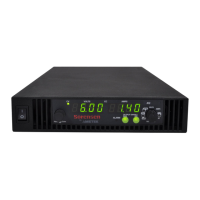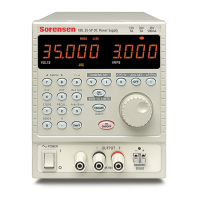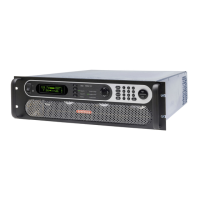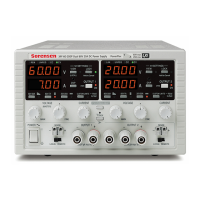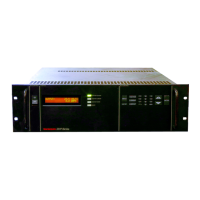Overview DC Asterion Series
3-52 M330460-01 Rev A
3.9 Parallel and Series Operation
Parallel and series modes of operation are used for applications requiring more current
or voltage than is available from a single power supply. To meet the requirements for
greater output current or voltage, up to five supplies could be connected in parallel, or
up to two supplies could be connected in series.
3.9.1 Parallel Operation
In order to connect up to five power supplies in parallel, use a “Master/Slave” daisy-
chain wiring configuration as follows; refer to Figure 3-111:
(There are two separate 9-pin connectors on the rear panel of each power supply,
marked “PAR OUT” and “PAR IN”. Also, there are two separate 9-pin connectors on
the rear panel of each power supply, marked ‘CAN OUT” and “CAN IN".)
1. Programming, readback, and control is performed through the Master.
2. Beginning with the power supply that is to function as the Master, use an
interface cable (890-524-01) to connect the PAR OUT connector on the
designated Master power supply to the PAR IN connector on the second power
supply (Slave 1). Repeat connection between Master CAN OUT and Slave 1
CAN IN.
3. On the second power supply (Slave 1), use another interface cable to connect
the PAR OUT connector to the PAR IN connector of the third power supply
(Slave 2). Continue these interconnections up to a maximum of 5 power
supplies. Repeat connection between Slave 1 CAN OUT and Slave 2 CAN IN.
4. Connect the Positive output terminals of all the power supplies and the load.
5. Connect the Negative output terminals of all the power supplies and the load.
6. Confirm that there are no shorts between the Positive and Negative output
terminals.
7. Referring to Figure 3-111, connect twisted-pair sense cables as follows; ensure
that all twisted-pair cables are as short as possible:
All slave units shall have twisted-pair cables from their sense terminals to their own
output terminals.
For remote sense at the load, the master unit shall have a twisted-pair cable from its
own sense terminals to the load terminals.
For remote sense at the output terminals (local sense connection), the master unit
shall have a twisted-pair cable from its own sense terminals to the output terminals of
its own chassis.
Note: The OVP circuit remains active for all units in parallel operation. If the units
are set to different OVP levels, the paralleled system will trip according to the
lowest setting. For ease of use, adjust the OVP levels for the slaves to
maximum and adjust the master OVP level to the desired setting.

